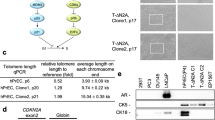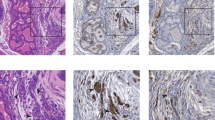Abstract
The CDKN2A locus is frequently inactivated in urothelial cell carcinoma (UCC), yet how this alteration contributes to bladder tumorigenesis is not known. Although most UCC express telomerase, inactivation of the p16/Rb pathway is generally required for in vitro immortalisation. This and the involvement of p16 in senescence of normal human urothelial cells (NHUC) suggest that CDKN2A deletion may aid bypass of senescence and allow immortalisation. CDKN2A encodes p16 and p14ARF and therefore inactivation of this locus can disrupt both the Rb and p53 tumour suppressor pathways. Retrovirus-mediated transduction was used to specifically modulate the p16/Rb and/or p53 tumour suppressor pathways in NHUC and to express human telomerase reverse transcriptase (hTERT). Expression of hTERT bypassed Rb and p53 pathway-dependent barriers to proliferation and immortalised NHUC. TERT-NHUC had normal karyotypes, were non-tumorigenic and unexpectedly retained CDKN2A. Thus, the phenotypic significance of inactivation of CDKN2A in UCC may not be solely related to bypass of senescence. Phenotypic assays in human urothelial cells have relied on cell strains derived from invasive tumours or NHUC immortalised by expression of SV40-large T. The production of genetically normal but immortal NHUC lines now provides a valuable platform for experiments to examine the timing and combination of events necessary for UCC tumorigenesis.
This is a preview of subscription content, access via your institution
Access options
Subscribe to this journal
Receive 50 print issues and online access
$259.00 per year
only $5.18 per issue
Buy this article
- Purchase on Springer Link
- Instant access to full article PDF
Prices may be subject to local taxes which are calculated during checkout







Similar content being viewed by others
References
Alani RM, Young AZ, Shifflett CB . (2001). Proc Natl Acad Sci USA 98: 7812–7816.
Alcorta DA, Xiong Y, Phelps D, Hannon G, Beach D, Barrett JC . (1996). Proc Natl Acad Sci USA 93: 13742–13747.
Aveyard JS, Knowles MA . (2004). J Mol Diagn 6: 356–365.
Belair CD, Yeager TR, Lopez PM, Reznikoff CA . (1997). Proc Natl Acad Sci USA 94: 13677–13682.
Bodnar AG, Ouellette M, Frolkis M, Holt SE, Chiu CP, Morin GB et al. (1998). Science 279: 349–352.
Bond J, Jones C, Haughton M, DeMicco C, Kipling D, Wynford-Thomas D . (2004). Exp Cell Res 292: 151–156.
Bond JA, Haughton MF, Rowson JM, Smith PJ, Gire V, Wynford-Thomas D et al. (1999). Mol Cell Biol 19: 3103–3114.
Cote RJ, Dunn MD, Chatterjee SJ, Stein JP, Shi SR, Tran QC et al. (1998). Cancer Res 58: 1090–1094.
Chapman EJ, Harnden P, Chambers P, Johnston C, Knowles MA . (2005). Clin Cancer Res 16: 5740–5747.
Counter CM, Meyerson M, Eaton EN, Ellisen LW, Caddle SD, Haber DA et al. (1998). Oncogene 16: 1217–1222.
Cuthill S, Agarwal P, Sarkar S, Savelieva E, Reznikoff CA . (1999). Genes Chromosomes Cancer 26: 304–311.
Dickson MA, Hahn WC, Ino Y, Ronfard V, Wu JY, Weinberg RA et al. (2000). Mol Cell Bio 20: 1436–1447.
Diggle CP, Pitt E, Roberts P, Trejdosiewicz LK, Southgate J . (2000). J Lipid Res 41: 1509–1515.
Drayton S, Peters G . (2002). Curr Opin Genet Dev 12: 98–104.
Elmore LW, Rehder CW, Di X, McChesney PA, Jackson-Cook CK, Gewirtz DA et al. (2002). J Biol Chem 20: 35509–35515.
Esteller M, Tortola S, Toyota M, Capella G, Peinado MA, Baylin SB et al. (2000). Cancer Res 60: 129–133.
Farwell DG, Shera KA, Koop JI, Bonnet GA, Matthews CP, Reuther GW et al. (2000). Am J Pathol 156: 1537–1547.
Harada H, Nakagawa H, Oyama K, Takaoka M, Andl CD, Jacobmeier B et al. (2003). Mol Cancer Res 1: 729–738.
Hemann MT, Strong MA, Hao LY, Greider CW . (2001). Cell 107: 67–77.
Hurst CD, Fiegler H, Carr P, Williams S, Carter NP, Knowles MA . (2004). Oncogene 23: 2250–2263.
Hutton KA, Trejdosiewicz LK, Thomas DF, Southgate J . (1993). J Urol 150: 721–725.
Lin M, Wei LJ, Sellers WR, Lieberfarb M, Wong WH, Li C . (2004). Bioinformatics 20: 1233–1240.
Lowe SW, Sherr CJ . (2003). Curr Opin Genet Dev 13: 77–83.
Knowles MA . (2001). Mol Pathol 54: 215–221.
Markl ID, Jones PA . (1998). Cancer Res 58: 5348–5353.
Muntoni A, Fleming J, Gordon KE, Hunter K, McGregor F, Parkinson EK et al. (2003). Oncogene 22: 7804–7808.
O’Hare MJ, Bond J, Clarke C, Takeuchi Y, Atherton AJ, Berry C et al. (2001). Proc Natl Acad Sci USA 98: 646–651.
Puthenveettil JA, Burger MS, Reznikoff CA . (1999). Adv Exp Med Biol 462: 83–91.
Rahat MA, Lahat N, Gazawi H, Resnick MB, Sova Y, Ben Ari G et al. (1999). Cancer 85: 919–924.
Rahman R, Latonen L, Wiman KG . (2005). Oncogene 24: 1320–1327.
Ramirez RD, Morales CP, Herbert BS, Rohde JM, Passons C, Shay JW et al. (2001). Genes Dev 15: 398–403.
Reznikoff CA, Yeager TR, Belair CD, Savelieva E, Puthenveettil JA, Stadler WM . (1996). Cancer Res 56: 2886–2890.
Rheinwald JG, Hahn WC, Ramsey MR, Wu JY, Guo Z, Tsao H et al. (2002). Mol Cell Biol 22: 5157–5172.
Sarkar S, Julicher KP, Burger MS, Della VV, Larsen CJ, Yeager TR et al. (2000). Cancer Res 60: 3862–3871.
Savelieva E, Belair CD, Newton MA, DeVries S, Gray JW, Waldman F et al. (1997). Oncogene 14: 551–560.
Shaulian E, Zauberman A, Ginsberg D, Oren M . (1992). Mol Cell Biol 12: 5581–5592.
Smith LL, Coller HA, Roberts JM . (2003). Nat Cell Biol 5: 474–479.
Stewart SA, Hahn WC, O’Connor BF, Banner EN, Lundberg AS, Modha P et al. (2002). Proc Natl Acad Sci USA 99: 12606–12611.
Wang H, Kavanaugh MP, North A, Kabat D . (1991). Nature 352: 729–731.
Wazer DE, Liu XL, Chu Q, Gao Q, Band V . (1995). Proc Natl Acad Sci USA 92: 3687–3691.
Wolfel T, Hauer M, Schneider J, Serrano M, Wolfel C, Klehmann-Hieb E et al. (1995). Science 269: 1281–1284.
Wootton M, Steeghs K, Watt D, Munro J, Gordon K, Ireland H et al. (2003). Hum Gene Ther 14: 1473–1487.
Yang A, Kaghad M, Wang Y, Gillett E, Fleming MD, Dotsch V et al. (1998). Mol Cell 2: 305–316.
Yang J, Chang E, Cherry AM, Bangs CD, Oei Y, Bodnar A et al. (1999). J Biol Chem 274: 26141–26148.
Yeager T, Stadler W, Belair C, Puthenveettil J, Olopade O, Reznikoff C . (1995). Cancer Res 55: 493–497.
Yeager TR, DeVries S, Jarrard DF, Kao C, Nakada SY, Moon TD et al. (1998). Genes Dev 12: 163–174.
Acknowledgements
This work was sponsored by Cancer Research UK. We are thankful to the following for supplying reagents and technical advice: David Beach (LinXE and LinXA), Gordon Peters (pWZL Eco receptor neo, pBabe hTERT puro), Moshe Oren (pBabe p53DD puro), Thomas Wolfel (pcDNA3 CDK4R24C), Eiji Hara (pcDNA3 Id-1 hygro), Darren Tomlinson (pFB-hygro). We are grateful to Paul Roberts (Cytogenetics Department, St James's University Hospital, Leeds, UK) and Stuart Pepper (Patterson Institute, Manchester, UK) for performing G-banded karyotype analyses and Affymetrix SNP array analyses, respectively.
Author information
Authors and Affiliations
Corresponding author
Rights and permissions
About this article
Cite this article
Chapman, E., Hurst, C., Pitt, E. et al. Expression of hTERT immortalises normal human urothelial cells without inactivation of the p16/Rb pathway. Oncogene 25, 5037–5045 (2006). https://doi.org/10.1038/sj.onc.1209513
Received:
Revised:
Accepted:
Published:
Issue Date:
DOI: https://doi.org/10.1038/sj.onc.1209513
Keywords
This article is cited by
-
The urothelium: a multi-faceted barrier against a harsh environment
Mucosal Immunology (2022)
-
A prospect of cell immortalization combined with matrix microenvironmental optimization strategy for tissue engineering and regeneration
Cell & Bioscience (2019)
-
ETV5 links the FGFR3 and Hippo signalling pathways in bladder cancer
Scientific Reports (2019)
-
Implications of TERT promoter mutations and telomerase activity in urothelial carcinogenesis
Nature Reviews Urology (2018)
-
Circadian coordination of ATP release in the urothelium via connexin43 hemichannels
Scientific Reports (2018)



